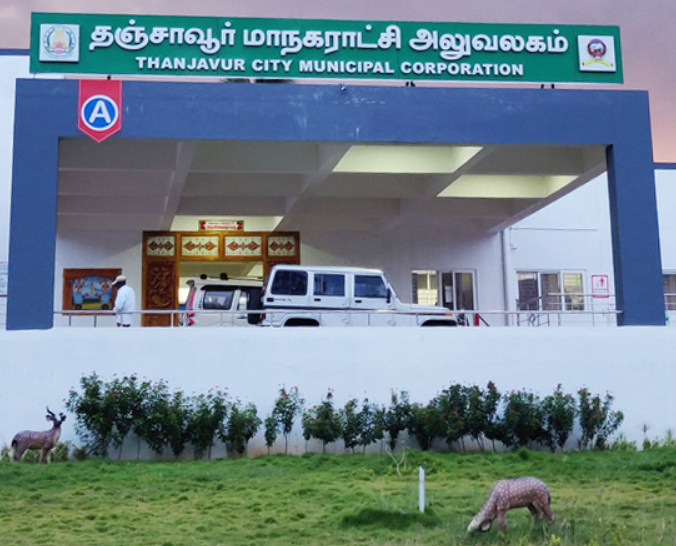Thanjavur is a city blessed with rich culture and heritage. The traditional legacy and cultural richness of the city can be seen in the exquisite paintings, classical carnatic music, musical instruments, colorful festivals and tempting cuisines that rightly define it as the cultural capital of Indian peninsula.
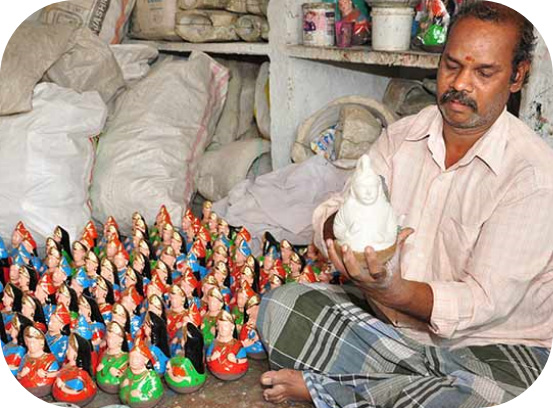
People
The people of Thanjavur are humble and joyful and love to celebrate various events accompanied with traditional dance and music. They mainly indulge in agricultural and handloom activities including the making of the famous Tanjore Doll, Tanjore paintings, bronze idols, art plate, silk carpets etc.


Religion and language
The main religion of the people of Thanjavur is Hinduism which is the oldest religion of the region along with its various sects. However, the people belonging to other religions such as Islam, Christianity and Jainism also reside in the city. The main languages to be spoken in Thanjavur are Tamil, Hindi and English.


Dancing dolls
Thanjavur’s fame also stems from the “Thalaiyatti bommai,” or “Dancing dolls,” which are dolls fashioned of clay, wood, or plastic.
The natives call these dolls “thanjavur Thalaiyatti Bommai,” or bobble head dolls or head shaking dolls. During the reign of Saraboji’s Kingdom in the 19th century, this artwork was created. The two primary varieties of Thanjavur dolls are the tufted head version and the bowing doll version. A metal band secures the doll’s head to its sturdy foundation, so when Dancing Girl, a bobblehead variant, is tapped on the head, it nods in response. Tilting dummies on the other hand are hollow and non-tilting. The term Raja-Rani Bommai or Gundu Chatti Bommai (round pot doll) are other names for the leaning doll from Thanjavur. Its motion direction is established by the rule of balance.


Fairs and Festivals
Apart from traditional festivals of India, Thanjavur is famous for its two important festivals namely Natyanjali Dance Festival and Carnatic Classical Musical Festival that represent the cultural richness of the city. The Natyanjali Dance Festival is a five days dance festival dedicated to Lord Natraj. The Carnatic Musical Festival is celebrated in the month of December and January which gathers a number of classical musicians all across the country.

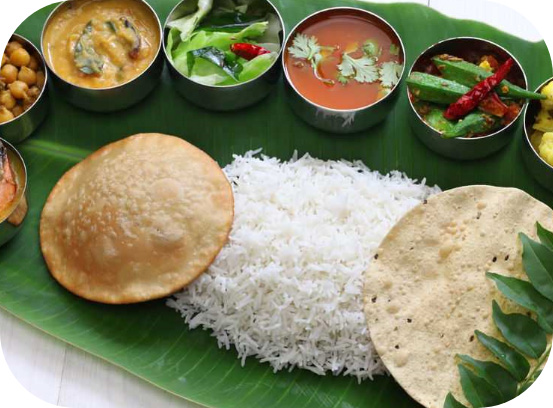
Food
The traditional food of Thanjavur includes a variety of tempting vegetarian and non vegetarian delicacies. The most famous vegetarian dish of this region is Thavala Adai, a kind of vada which is eaten with rasam. Besides, the local inhabitants prefer to eat all the dishes of South Indian cuisine such as dosa, idly, boiled rice, uttapam and vada etc. Apart from it, the sea food like fish, crabs, lobsters etc are very common among the locals of Thanjavur.


THANJAVUR VEENA
Raghunathanayakkar developed the renowned Thanjavur veena. The rectangular pandal, also known as the kudam (pot-shaped part of the veena) and the short koodu (portion of strings) were the features of the veena in Tamilnadu until his time.
The koodu portion had 16+1 (metukkal) strings. It was constructed with metal strings that were wax-fastened to the stem. We called this melam. In order for musicians to perform a different raga, they must alter the mettukkal. This forced them to employ veenas with saarangi-style fret arrangements.
In order to overcome this, Raghunathannayakar stretched the tail portion with a piece of wooden plank using his expert talent.By doing this, he increased the number of mettukkal from 18 to 24 by adding 8 more. As a result, there was an increase.


THANJAVUR FORT
The chola era saint Karuvoorar (also known as Karuvoorsithar) sang as “Injisoolthanjai.” We concluded from this that there were forts in Thanjavur. There are two historically significant forts in Thanjavur: Little Fort and Big Fort.
Sevvappanayakar built a small fort between the years of 1541 and 1580 B.C. It includes Swartz (Christian) church, large temple, park, and Shivaganga Pond.
Vigayaraghavanayakkar, the final monarch of the Sevappanayaka Dynasty, built the large fort between 1630 and 1674 B.C. Its 530 acres encompass the palace, a location of employment, and human habitation.


TEMPLE CAR BOARDING PLACE
It is also called term mole. Every temple used to have one for a car. It is used to secure cars and as a starting point for processions in festivals and ceremonies. It is also used to decorate the car and also as a decorative platform. The Thanjavur car park is located on the main road on the western side, which is built of brick and lime mortar. The architectural style belongs to the period of the Nayakkas and can be concluded to belong to the same.


MOAT OF THANJAVUR
In the city of Thanjavur, moats were built next to the fort wall surrounding the city as a defense barrier. The area of the moat is 150 feet wide by 4 miles long. The fort adjacent to this fort was built around a big temple in 4 sides with moats on each side. The moat on the western side of the big temple was built in 1935 as Mettur Dam Development activity as Kallanai Water Channel. In other words, puthuaaru was formed as a new river with the western moat as the river water outlet. Today, the southern part of the Moat has disappeared while the east, west and south moats remain.
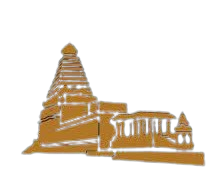

THANJAVUR QUARTETS
In the 17th century, Thanjavur nurtured cultural luminaries like the Thevaram-singing poet Oothuvaar and his descendants, who served as musicians and dancers in the court of Thanjavur Maratta king Thulaja. Subburayan and his sons, renowned for crafting garlands for the Lord Siva Temple, impressed King Thulaja with their musical skills, leading to their appointment as instructors at the Thanjavur temple. Ponnaiyah, driven to refine Bharathanatyam, devised ten foundational adavus, essential for Bharathanatyam training and performance, thus contributing significantly to the art form’s development.


KALAYANASUNDARAM HIGHER SECONDARY SCHOOL
One of the oldest famous schools, started on April 16, 1891, commonly known as K.H.S. founded by great personalities Gopalasamy Iyengar, K.Dharmarasa Iyengar and T.R.Arangasamy Iyengar. With the help and support of Kalyanasundarm Iyer, a famous lawyer and member of the Legislative Assembly, the school receives state aid. After that, it was transferred to high school. In 1927, the administration of the school was transferred to the Kalyanasundara Education Commission.


RICE GRANARY
Primitive people used to be nomads. Having settled in a place where agriculture was practiced for food production, they began to store food in pots and trenches. Archaeological evidence indicates that storage of food grains dates back to the Upper Stone Age. In later years, the granary was called kottaram. At places along the Cauvery River, many temples had the facility to store rice parcels.
The Lord Renganathar Temple of Srirangam has three rice warehouses. Thirupalathuraipalaivanathari templis. Achuthappa Nayakkar, temo poet Raghunatha Nayakkar kaj temo guru Govindappa theetchidar rajasid riisilao, mile mahutavus sur 3000 kaalami riisipaberit..


SANGEETHA MAHAL
The Thiruvisaipaa publication of Karurthevar mentions the presence of young dancers in Thanjavur, a tradition upheld for years, showcased notably in the Sangeetha Mahal. This palace, unique in Tamil Nadu, stands as a testament to Thanjavur’s musical legacy. The two-story rectangular structure, with the lower floor hosting royalty, musicians, and civilians, and the upper floor reserved for queens to view performances, features a spacious stage and ample seating. Originally known as “navarethana myna naadagasaala” during the Nayakka period and later renamed Sangeetha Mahal during Maratta rule, the hall boasts remarkable architectural design conducive to dance and music.
Its acoustic properties are enhanced by a water-filled pool in front of the stage, strategically placed holes to mitigate echo, and thick curtains to dampen sound. Despite lacking modern sound technology, the hall accommodates up to 1000 spectators comfortably, showcasing performances with clarity and charm. Currently under the jurisdiction of the District Collector, the hall continues to host cultural events, maintaining its historical significance.


SARASWATHI MAHAL LIBRARY
For over a millennium, Thanjavur has been renowned for its diverse art, architecture, culture, and literature, shaped significantly by the Chola, Nayakka, and Maratta kingdoms. The Chola dynasty’s temples and artworks stand out for their distinctiveness, while the Nayakkas contributed to literature, music, and drama. The Marathas, known for their patronage, safeguarded and influenced the preservation of libraries.
During Ragunathanayakkar’s reign, the Vijayavilasam library was established, further developed by Maratta Seraphs II. In 2005, a committee was formed to manage the library, financially supported by the government, ensuring the preservation and publication of manuscripts. The Saraswathimahal Library was notably registered as the first society under the Tamil Nadu New Registration Act in 1975, following advice from a former Prime Minister.

FESTIVALS AND EVENTS
| NAME OF FESTIVAL | MONTH OF FESTIVAL | PLACE OF FESTIVAL |
| Thyagaraja Aradhana Festival | January | Thiruvaiyaru |
| Natyanjali Dance festival (Mahashivarathiri) | Tamil month of maasi in between Feb &March | Thanjavur big temple |
| Mahamaham (occur once in 12 yrs) | Tamil month of maasi in between Feb& march | Kumbakonam |
| Thanjavur car festival (Chithirai thiruvizha) | In between april &may | Thanjavur |
| Sathaya Vila (Raja Raja Cholan B.day) | Tamil month of aipassi (sadhayam star) in between Oct&Nov | Thanjavur |
Things to do

Temple
317 destinations

Art Gallery
317 destinations

Fair Mela
317 destinations

Picnic
317 destinations

Fort Monuments
317 destinations
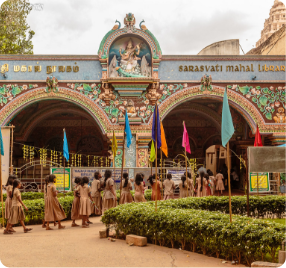
Museum
317 destinations

Church
317 destinations

Palace Bird Watching
317 destinations

Garden
317 destinations

Dams
317 destinations

Lakes
317 destinations

Scenic
317 destinations
Thanjavur City’s Emergency Number
These are some emergency helpline numbers which can be made a call on, during various problems. You need not panic when in an emergency. The number of police and ambulance is mentioned.

108
Ambulance
Emergency Ambulance Number

100
Police
Emergency Police Number





